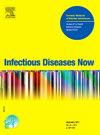二级医院急诊科抗生素管理方案的影响
IF 2.2
4区 医学
Q2 INFECTIOUS DISEASES
引用次数: 0
摘要
导言急诊科(ED)通常是患者与医院之间的第一个接触点。目前尚无确凿证据评估急诊科抗生素监管计划(ASP)的活动。我们的目的是评估 2019 年 5 月在急诊室实施 ASP 后抗生素处方的合理性,并确定与抗生素处方不当相关的风险因素。方法 我们对西班牙阿尔科尔孔基金大学医院(一家二级大学医院)急诊室收治的患者进行了横断面研究。研究纳入了2019年5月、2021年3月以及2022年10月至11月期间急诊室收治的所有患者。我们分析了人口统计学数据、流行病学变量、合并症、经验性抗生素治疗、既往分离情况和治疗持续时间。结果 共纳入 402 名患者。在第一和第二阶段,抗生素合理性没有明显改善(50% 对 57.3%;OR = 1.3,95 % CI:0.65-2.76,p = 0.424),而在第一和第三阶段,抗生素合理性有所提高(50% 对 71.2%;OR = 2.47,95 % CI:1.28-4.79,p = 0.007)。与抗生素不足相关的因素有:使用导尿管(33% 对 56%,P = 0.008,OR:2.62,95 % CI:1.29-5.33)、有耐多药微生物感染/定植史(32% 对 57%,P = 0.碳青霉烯类药物的总体使用率为 9 %(n = 36),在第一和第三阶段的使用率有所下降(26.2 % vs. 7 % vs. 7 %,p <0.01)。本文章由计算机程序翻译,如有差异,请以英文原文为准。
Impact of an antibiotic stewardship programme in the emergency department of a secondary hospital
Introduction
Emergency Departments (ED) are usually the first point of contact between patients and hospitals. There is no solid evidence evaluating the activity of antibiotic stewardship programs (ASP) in EDs. We aimed to assess antibiotic prescription appropriateness after the implementation of an ASP in an ED in May 2019 and to determine the risk factors associated with inappropriate antibiotic prescription.
Methods
A cross-sectional study was conducted with patients admitted to the ED of the University Hospital Fundación Alcorcón, a second-level university hospital in Spain. All patients admitted to the ED in May 2019, March 2021, and between October and November 2022 were included. We analyzed demographic data, epidemiological variables, comorbidities, empirical antibiotic treatment, previous isolations, and treatment duration. A 30-day follow-up was implemented.
Results
A total of 402 patients were included. No significant improvement in antibiotic appropriateness was observed between the first and second periods (50 % vs. 57.3 %; OR = 1.3, 95 % CI: 0.65–2.76, p = 0.424), while antibiotic appropriateness increased between the first and third periods (50 % vs. 71.2 %; OR = 2.47, 95 % CI: 1.28–4.79, p = 0.007). Factors associated with antibiotic inadequacy were having a urinary catheter (33 % vs. 56 %, p = 0.008, OR: 2.62, 95 % CI: 1.29–5.33), a history of infection/colonization by multidrug-resistant microorganisms (32 % vs. 57 %, p = 0.007), and coming from a retirement home or medium-stay hospital (32 % vs. 47 % vs. 53 %, p = 0.015).The overall use of carbapenems was 9 % (n = 36), showing a decrease in consumption between the first and third periods (26.2 % vs. 7 % vs. 7 %, p < 0.01).
求助全文
通过发布文献求助,成功后即可免费获取论文全文。
去求助
来源期刊

Infectious diseases now
Medicine-Infectious Diseases
CiteScore
7.10
自引率
2.90%
发文量
116
审稿时长
40 days
 求助内容:
求助内容: 应助结果提醒方式:
应助结果提醒方式:


